Introduction to E-Medicine
The shift to e-medicine structure seems to be inevitable today when health care specialists need to operate a large scale of health-related data and meet the requirements of health-conscious patients under the conditions of limited funding. Hence, e-medicine is a good alternative as it makes the service more available – patients can get their consultations without leaving home; affordable – the only equipment required is the laptop that reduces the cost of the service; accountable – managers have an opportunity to monitor employees’ on-line performance opposite to traditional services. In the meantime, the shift to e-medicine implies a series of challenges. The funding naturally decreased, while patients expect to receive the service that is of equal quality as a live consultation. In addition, healthcare specialists have to learn to operate the new reporting forms and documents. The shift to e-medicine targets several objectives. First and foremost, it is aimed at simplifying the data operating process – employees are enabled to share and process the relevant data in a quick and convenient manner. Second, it is expected that the technologies will help to improve the communication within healthcare organizations and between patients and specialists. Finally, it is aimed at helping professionals to perform effective decision-making with the help of digital resources and quick access to associated organizations (Tan.)
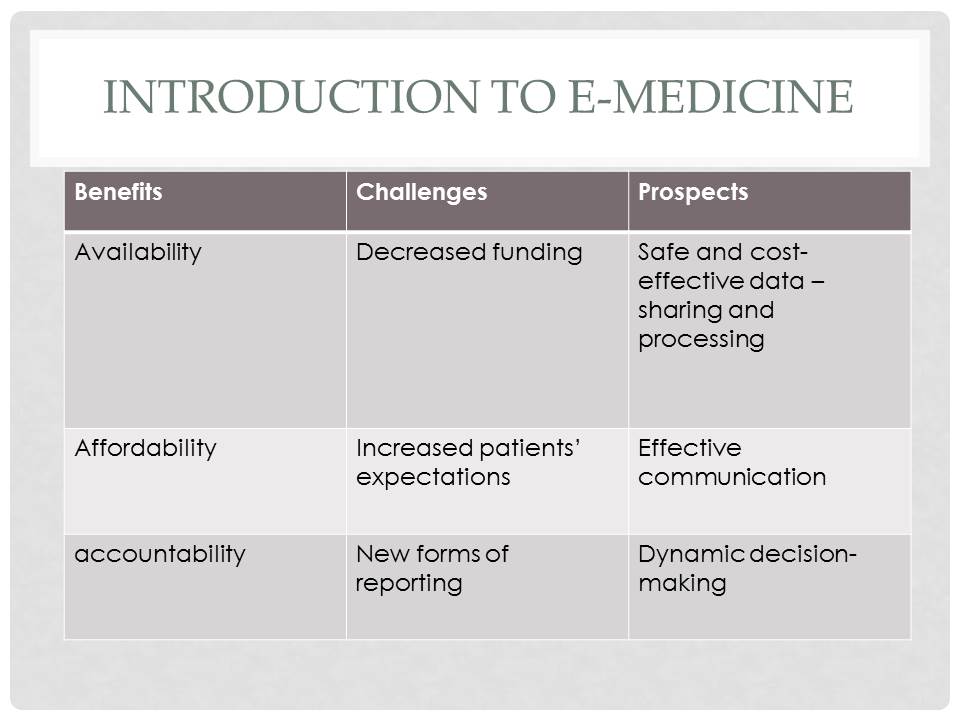
Telehealth
Telehealth implies the provision of healthcare services through electronic ITs.
Key Areas of Advances
- Gap service coverage;
- Urgent services;
- Mandated services.
The implementation of Telehealth allows addressing the areas of healthcare that are most problematic to address through traditional methods. Thus, the gap service coverage implies providing night-time service in such important departments as cardiology. Urgent services coverage implies offering such progressive services as telestroke (applying telemedicine to treat vascular strokes) and teleburn (connects patients and healthcare specialists through video conference programs). Mandated services coverage implies delivering healthcare services to problem population groups such as prisoners (Weinstein et al., 2014).
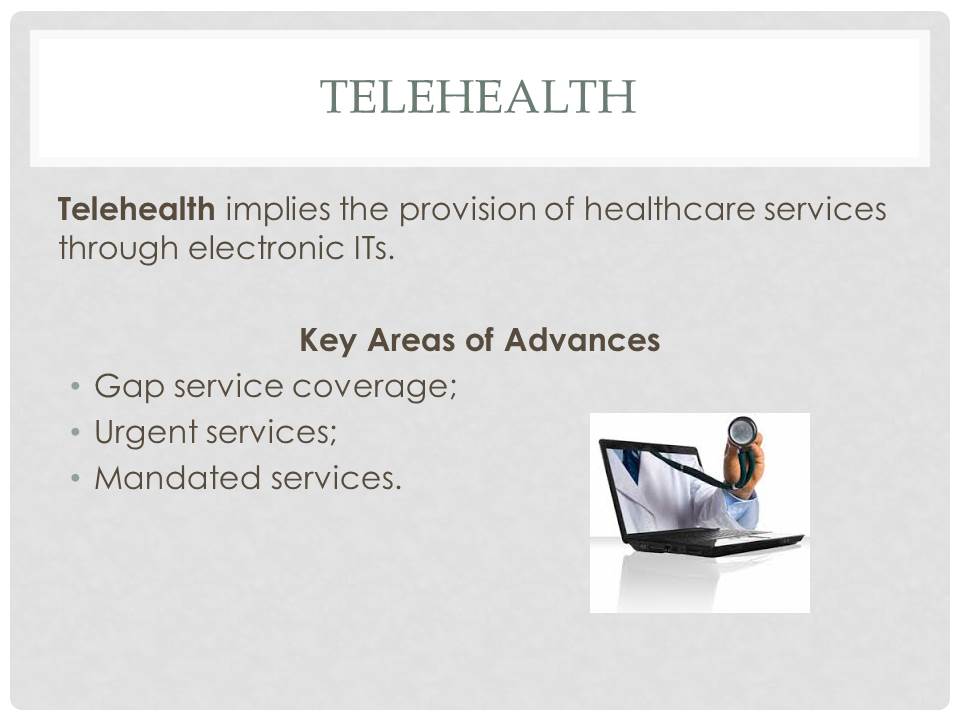
Telehealth: Available Technologies
Telehealth applications:
- Teleradiology;
- Professional education;
- Home monitoring.
These areas of application are the most common types of Telehealth services currently used. Teleradiology implies operating the test results by sharing the data within the target departments to establish a diagnosis. Home monitoring implies providing additional nursing consultations and assistance supplement to traditional home visits. Professional education implies using Telehealth technologies for operating scientific data, carrying out research and discussing the critical issues through video conferences.
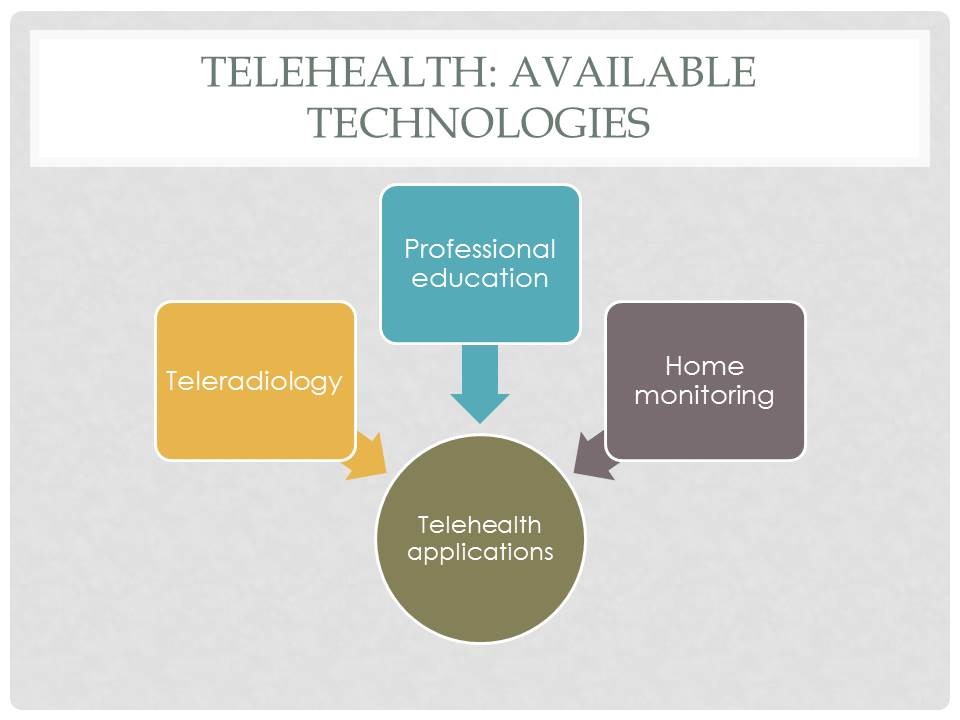
Telehealth: Technologies’ Comparison
Real-time communication might likewise involve professional conferences for experience sharing. The store-and-forward option likewise implies sharing medical records within departments for a prompt service provision.
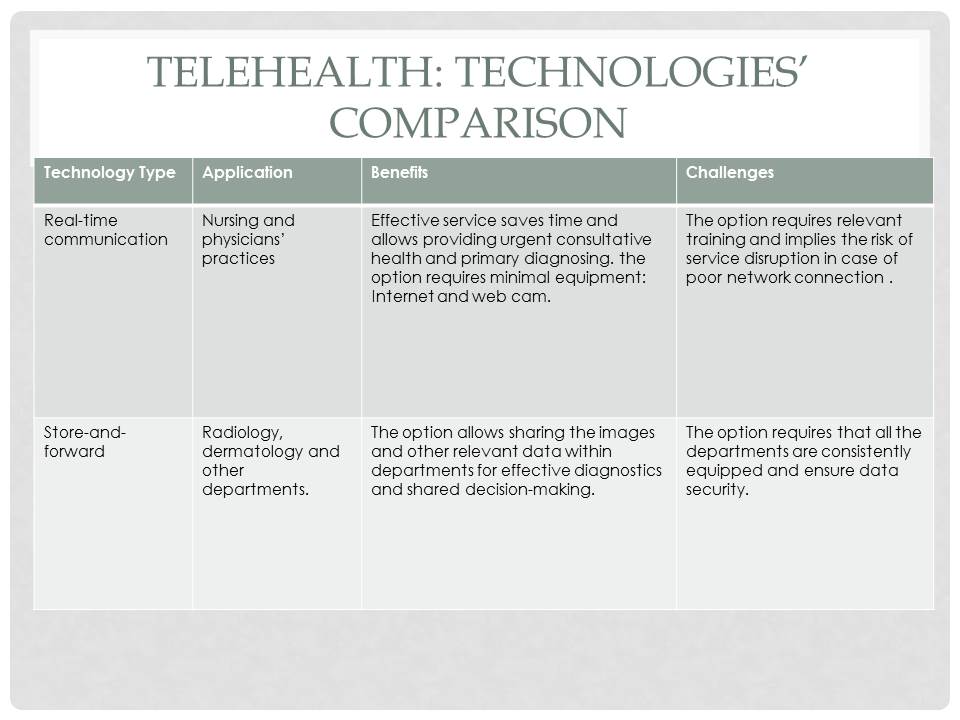
Telehealth: Barriers to Implementation
Barriers:
- Patients’ resistance to change;
- Special technical competence required;
- Self-reliance and self-discipline required;
- Service disruptions.
Recent research has revealed the most critical barriers to the implementation of Telehealth. Hence, lots of patients show resistance to the change preferring to use the familiar type of services. Secondly, patients complain about the technical side of the service. Hence, the use of Telegraph requires possessing special skills to work with the relevant equipment. In addition, some patients complain about the service disruptions – in other words, the service’s consistency depends on the Internet connection and other technical factors that patients cannot control. Finally, Telegraph implies extra self-care activities – the patients are supposed to have enough self-discipline to carry out an effective treatment (Sanders et al., 2012).

Telehealth: Associated Statistics
- 30% US patients already use Telehealth for monitoring diagnosis and health records;
- 70% US patients already communicate with their practitioners through Telehealth services;
- 74% US patients would like to use Telegraph options;
- 76% US patients believe that quick access to the service is more important than the live character of a consultation.
According to the research carried out by American Hospital Association, Telehealth options attract the majority of US patients; the latter is generally willing to replace live contacts by distant assistance. Meanwhile, it is now essential that healthcare organizations perform a smooth and effective shift to Telehealth (American Hospital Association, 2015).
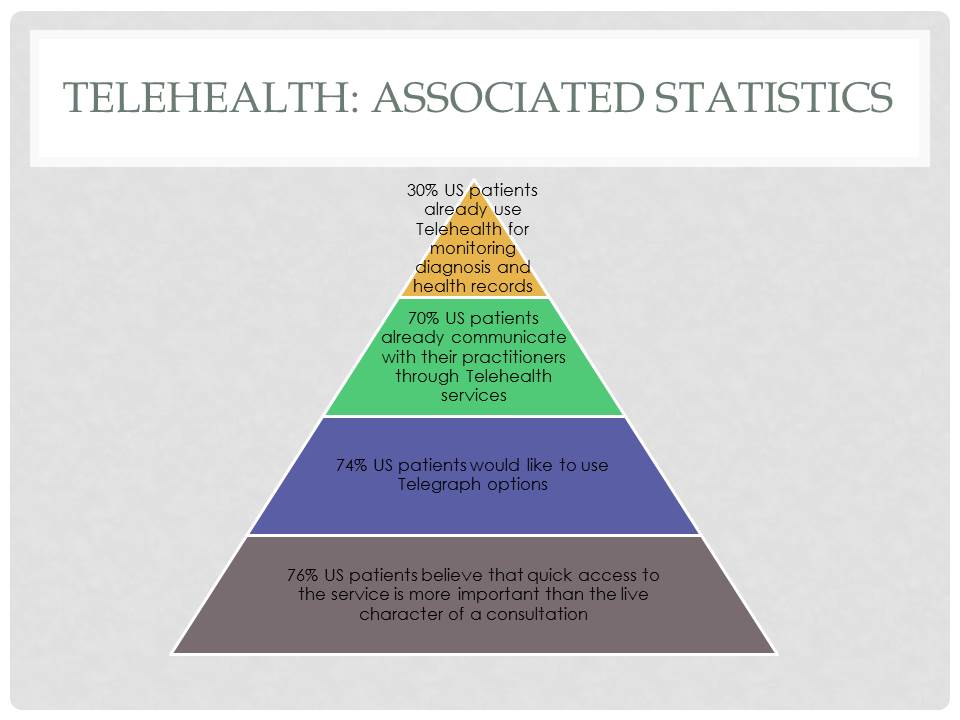
Recommendation 1
The implementation of Telehealth can be guided by the following checklist that includes the key points that need to be considered:
- Identifying needs and shareholders;
- Generating a consistent strategy;
- Ensuring long-term funding;
- Preparing personnel and patients for the change;
- Monitoring and evaluating the progress.
The represented list was proposed by a group of British researchers. It relies on the examination of 13 British healthcare organizations that have already implemented the elements of Telehealth in their services. The organizations were asked to identify the most critical challenges that they faced in order to help their colleagues foresee potential risks (Joseph et al., 2011). This list might help healthcare organizations to work out an effective change plan.
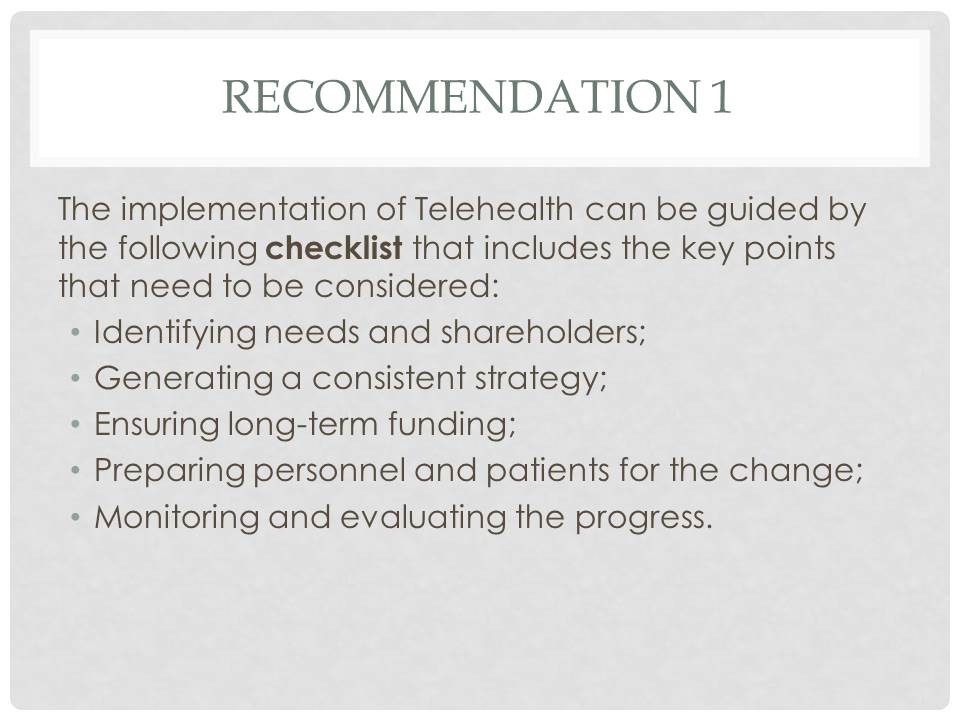
Recommendation 2
Telehealth can be used as a supplementary element of the general course of treatment.
+ Simplifies consultations for long-term conditions.
– Requires additional funding.
Recent study elucidated the implementation of the Telehealth techniques as a supplementary measure for long-term conditions. According to the findings, the method allows performing medical consultations distantly that is particularly convenient for the patients with long-term conditions that only need to report the progress and clarify further instructions. In the meantime, the research likewise showed that the approach is rather costly as it does not exclude standard medical care but requires extra expenses for additional services (Cartwright et al., 2013).
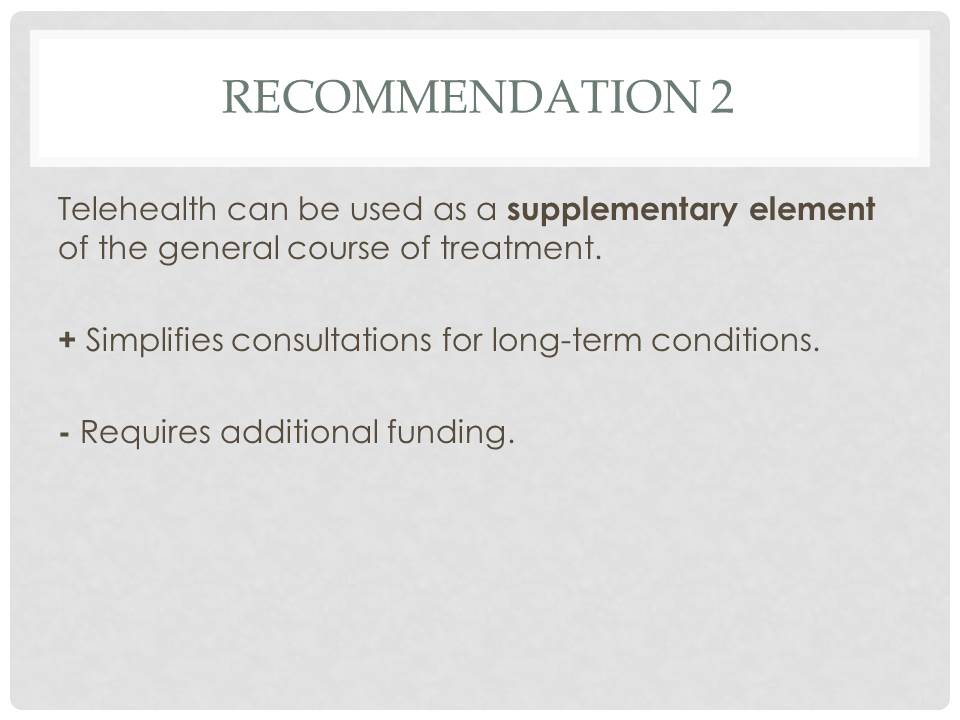
Recommendation 3
The implementation of Telehealth can start with providing service for population groups with limited access to healthcare centers.
+ It will cover the service gaps in attending groups that have difficulties accessing the live service: elderly people, rural residents, etc.
– Requires additional training to use the new technologies.
Recent research revealed the benefits of Telehealth in terms of serving “problematic” groups of patients. Hence, for instance, it has been revealed that elderly patients that have difficulties with accessing the centers on a regular basis might be addressed distantly. Research shows that the implementation of Telehealth helps to improve the diagnosing services and prevent disease progressing at early stages. In the meantime, it is essential to take into account the fact that certain groups such as elderly patients might need to receive the relevant training to learn to operate the equipment (Gellis et al., 2012).
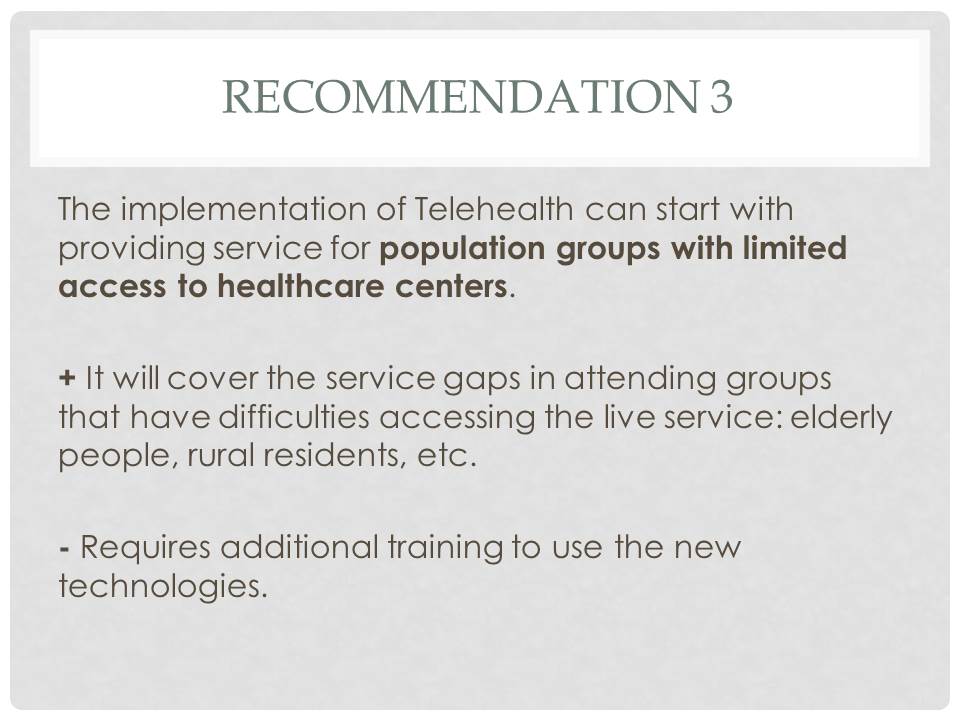
Conclusion
The Rationale for Implementing Telehealth:
- Effective data management;
- New opportunities for communication;
- The coverage of gap services;
- The way to address “problematic” groups.
Therefore, the shift to Telehealth offers a wide range of prospects. First and foremost, healthcare specialists will be able to simplify the process of data management – Telehealth allows storing and sharing large scopes of data and exchanging them within different departments. Second, healthcare specialists can use Telehealth options to perform online conferences and share the professional knowledge and experience. In addition, Telehealth is expected to assist in covering the so-called “gap services”: night-time consultations, assistance for prisoners, etc. Finally, Telehealth will help to address those patients that have limited access to healthcare organizations: elderly people, rural patients, etc.
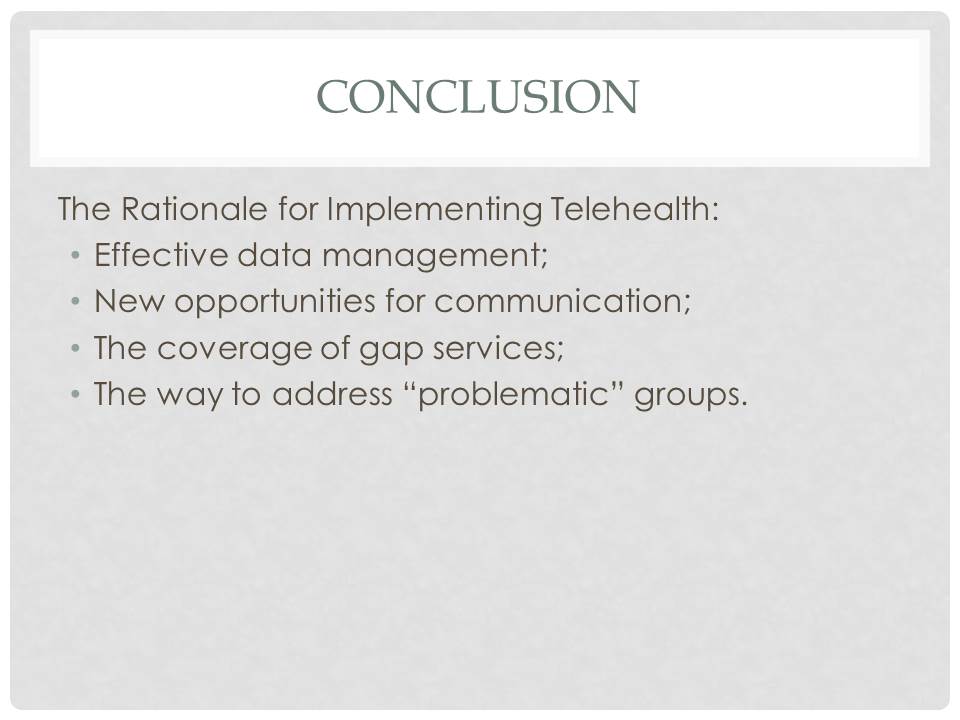
Reference List
American Hospital Association. (2015). The promise of Telehealth for hospitals, health systems And their communities. Web.
Cartwright, M., Hirani, S. P., Rixon, L., Beynon, M., Doll, H., Bower, P., Bardsley, M., Steventon, A., Knapp, M., Henderson, C., Rogers, A., Sanders., C., Fitzpatrick., R., Barlow, J., & Newman, S. P. (2013). Effect of telehealth on quality of life and psychological outcomes over 12 months (Whole Systems Demonstrator telehealth questionnaire study): nested study of patient reported outcomes in a pragmatic, cluster randomised controlled trial. British Medical Journal, 346(1), 1035-1058.
Gellis, Z. D., Kenaley, M., McGinty, J., Bardelli, E., Davitt, J., & Have, T. T. (2012). Outcomes of a Telehealth intervention for homebound older adults with heart or chronic respiratory failure: A randomized controlled trial. The Gerontologist, 52(4), 541-552.
Joseph, V., West, R. M., Shickle, D., Keen, J., & Clamp, S. (2011). Key challenges in the development and implementation of Telehealth projects. Journal of Telemedicine and Telecare, 17(2), 71-77.
Sanders, C., Rogers, A., Bowen, R., Hirani, S., Fitzpatrick, M. C., Knapp, M., Barlow, J., Hendy, J., Chrysanthaki, T., Bardsley, M., & Newman, S. P. (2012). Exploring barriers to participation and adoption of telehealth and telecare within the Whole System Demonstrator trial: a qualitative study. BMC Health Services Research, 12(1), 220-230.
Weinstein, R. S., Lopez, A. M., Joseph, B. A., Erps, K. A., Holcomb, M., Barker, G. P., & Krupinski, E. A. (2014). Telemedicine, Telehealth, and Mobile Health Applications that work: opportunities and barriers . The American Journal of Medicine,127(3), 183-187.